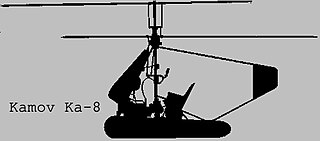
The Kamov Ka-8 "Иркутянин",, was a small, single-seat Soviet helicopter that first flew in 1947. It was a precursor of the Ka-10. The Ka-8 was powered by a 27 hp M-76 engine, boosted to 45 hp by using alcohol for fuel. It was derived from a previous Kamov design, the KA-17.

The Bensen B-8 is a small, single-seat autogyro developed in the United States in the 1950s. Although the original manufacturer stopped production in 1987, plans for homebuilders are still available as of 2019. Its design was a refinement of the Bensen B-7, and like that aircraft, the B-8 was initially built as an unpowered rotor-kite. It first flew in this form in 1955, and on 6 December a powered version, designated B-8M first flew. The design proved to be extremely popular and long-lasting, with thousands of sets of plans sold over the next thirty years.

Wing Commander Kenneth Horatio Wallis was a British aviator, engineer, and inventor. During the Second World War, Wallis served in the Royal Air Force and flew 28 bomber missions over Germany; after the war, he moved on to research and development, before retiring in 1964. He later became one of the leading exponents of autogyros and earned 34 world records, still holding eight of them at the time of his death in 2013.
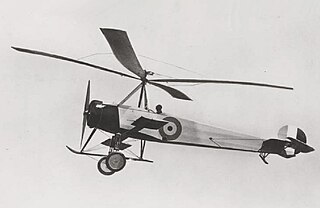
The Cierva C.6 was the sixth autogyro designed by engineer Juan de la Cierva, and the first one to travel a "major" distance. Cierva, the engineer responsible for the invention of the autogyro, had spent all his funds on the research and creation of his first five prototypes. Therefore, in 1923, he turned to the Cuatro Vientos Aerodynamics Laboratory chief, Commander Emilio Herrera, who succeeded in persuading General Francisco Echagüe, the director of the Military Aviation Aeronautics Department, to take over the second stage in the research and development of Cierva's autogyros.

The Cierva W.11 Air Horse was a helicopter developed by the Cierva Autogiro Company in the United Kingdom during the mid-1940s. The largest helicopter in the world at the time of its debut, the Air Horse was unusual for using three rotors mounted on outriggers, and driven by a single engine mounted inside the fuselage.

The Kayaba Ka-1 and Ka-2 were Japanese autogyros, seeing service during World War II for artillery spotting.

The Cierva C.8 was an experimental autogyro built by Juan de la Cierva in England in 1926 in association with Avro. Like Cierva's earlier autogyros, the C.8s were based on existing fixed-wing aircraft fuselages – in this case, the Avro 552.

The Cierva C.19 was a 1930s British two-seat autogyro, designed by Spanish engineer Juan de la Cierva. It was built by Avro as the Avro Type 620. It proved to be the most successful and widely produced of the early de la Cierva designs.

The Kellett KD-1 was a 1930s American autogyro built by the Kellett Autogiro Company. It had the distinction of being the first practical rotary-wing aircraft used by the United States Army and inaugurated the first scheduled air-mail service using a rotary-wing aircraft.
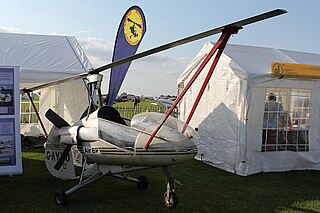
The Wallis WA-120 is an experimental British autogyro developed by Ken Wallis.

The KB-2 Freedom Machine is an autogyro designed by Ken Brock based on the designs of the Bensen B-8.
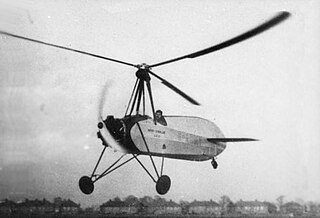
The Hafner A.R.III Gyroplane was a British 1930s experimental autogyro designed by Austrian Raoul Hafner, and built by the A.R.III Construction Company at Denham, Buckinghamshire.
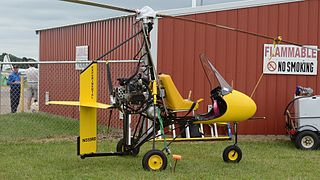
The Rotor Flight Dynamics Dominator is an American autogyro designed by Ernie Boyette of Rotor Flight Dynamics of Wimauma, Florida, and made available in the form of plans and kits for amateur construction.
The Celier Kiss is a series of Polish autogyros that was designed by Frenchman Raphael Celier and produced by his company, Celier Aviation of Jaktorów-Kolonia, Poland. When it was available the aircraft was supplied as a kit for amateur construction or as a complete ready-to-fly-aircraft.
The Cierva C.29 was a five-seat British cabin autogyro built in 1934 as a joint venture between Westland Aircraft and Cierva. The rotor system and rotors were designed by Cierva and the fuselage by Westland. It was powered by a 600 hp (447 kW) Armstrong Siddeley Panther II engine with a two-bladed tractor propeller; the engine also drove the three-bladed rotor via a clutched shaft. The C.29 suffered from ground resonance during ground running and was not flown. It was later acquired for evaluation by the Royal Aircraft Establishment but it was unable to cure the resonance problem and the autogyro was scrapped in 1939.
The Midwest Hornet is an American autogyro that was designed by Don Shoebridge and made available by Midwest Engineering & Design in the form of free plans for amateur construction.
The Taggart GyroBee is an American autogyro that was designed by Ralph E. Taggart of Michigan State University and made available as free documentation. The aircraft is also produced in kit form by Star Bee Gyros of Worcester, Massachusetts for amateur construction.
The Kharkov KhAI-24 was a 1960s Soviet two-seat autogyro designed by the Kharkiv Aviation Institute.
The Little Wing Roto-Pup is an American autogyro that was designed and produced by Little Wing Autogyros, Inc. of Mayflower, Arkansas, introduced in the 1990s. Now out of production, when it was available the aircraft was supplied as a kit for amateur construction.
The Aviomania G1SA Genesis Solo is a Cypriot autogyro that was designed by Nicolas Karaolides and produced by Aviomania of Larnaca. Now out of production, when it was available the aircraft was supplied as a complete ready-to-fly-aircraft or as a kit for amateur construction.













